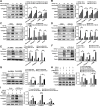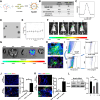Localized Administration of Bcar3 siRNA via Nano-Self-Assembly to Treat Idiopathic Pulmonary Fibrosis by Disrupting Macrophage-Fibroblast Crosstalk
- PMID: 38414524
- PMCID: PMC10898485
- DOI: 10.2147/IJN.S444470
Localized Administration of Bcar3 siRNA via Nano-Self-Assembly to Treat Idiopathic Pulmonary Fibrosis by Disrupting Macrophage-Fibroblast Crosstalk
Abstract
Background: Idiopathic pulmonary fibrosis (IPF) is a severe interstitial lung disease characterized by chronic lung injury leading to macrophage infiltration and fibroblast activation. However, there is no effective therapeutic strategy targeting the crucial crosstalk between macrophages and fibroblasts to halt IPF progression.
Methods: Studies were conducted in IPF patients and fibrotic mice models to elucidate the role of Bcar3 in the pathogenesis of pulmonary fibrosis. The effect of Bcar3 on macrophage polarization, fibroblast activation, and related signaling pathways were next investigated to unravel the underlying mechanisms.
Results: Our study elucidates a marked increase in Bcar3 expression in lung tissues from IPF patients and fibrotic mice, recording 1.7 and 7.8-fold increases compared to control subjects, respectively. Additionally, Bcar3 was found to significantly enhance macrophage activation and fibroblast differentiation, observable in both in vivo and in vitro settings. Mechanistically, the upregulation of Bcar3 in macrophages was reliant on Stat6, while in fibroblasts, it depended on TGFβR1/Smad3. Furthermore, Bcar3 augmented IL-4/Stat6 pathway in macrophages and TGF-β/Smad3 pathway in fibroblasts, supporting a synergistic activation loop that expedited lung fibrogenesis. Notably, intratracheal injection of liposomes containing Bcar3 siRNA precisely delivered gene therapeutics to lung macrophages and fibroblasts, effectively reducing Bcar3 expression to 59% of baseline levels. Importantly, this intervention protected mice from lung fibrosis induced by either FITC or bleomycin, as well as human precision-cut lung slices against TGF-β1 stimulation.
Conclusion: Our study underscores the pivotal role of Bcar3 in orchestrating the macrophage-fibroblast crosstalk during pulmonary fibrosis progression. Targeting Bcar3 emerges as a novel therapeutic avenue to halt IPF progression and enhance patient prognosis.
Keywords: Bcar3; fibroblasts; idiopathic pulmonary fibrosis; liposomes; macrophages.
© 2024 Zeng et al.
Conflict of interest statement
The authors declare that they have no competing interests in this work.
Figures







Similar articles
-
Iron-laden macrophage-mediated paracrine profibrotic signaling induces lung fibroblast activation.Am J Physiol Cell Physiol. 2024 Oct 1;327(4):C979-C993. doi: 10.1152/ajpcell.00675.2023. Epub 2024 Aug 26. Am J Physiol Cell Physiol. 2024. PMID: 39183565
-
Suppressing Sart1 to modulate macrophage polarization by siRNA-loaded liposomes: a promising therapeutic strategy for pulmonary fibrosis.Theranostics. 2021 Jan 1;11(3):1192-1206. doi: 10.7150/thno.48152. eCollection 2021. Theranostics. 2021. PMID: 33391530 Free PMC article.
-
Local administration of liposomal-based Srpx2 gene therapy reverses pulmonary fibrosis by blockading fibroblast-to-myofibroblast transition.Theranostics. 2021 May 13;11(14):7110-7125. doi: 10.7150/thno.61085. eCollection 2021. Theranostics. 2021. PMID: 34093874 Free PMC article.
-
Angiotensin-TGF-beta 1 crosstalk in human idiopathic pulmonary fibrosis: autocrine mechanisms in myofibroblasts and macrophages.Curr Pharm Des. 2007;13(12):1247-56. doi: 10.2174/138161207780618885. Curr Pharm Des. 2007. PMID: 17504233 Review.
-
Macrophage polarization and its impact on idiopathic pulmonary fibrosis.Front Immunol. 2024 Jul 26;15:1444964. doi: 10.3389/fimmu.2024.1444964. eCollection 2024. Front Immunol. 2024. PMID: 39131154 Free PMC article. Review.
Cited by
-
Deciphering the Role of BCAR3 in Cancer Progression: Gene Regulation, Signal Transduction, and Therapeutic Implications.Cancers (Basel). 2024 Apr 26;16(9):1674. doi: 10.3390/cancers16091674. Cancers (Basel). 2024. PMID: 38730626 Free PMC article. Review.
-
Trigonelline hydrochloride attenuates silica-induced pulmonary fibrosis by orchestrating fibroblast to myofibroblast differentiation.Respir Res. 2024 Jun 15;25(1):242. doi: 10.1186/s12931-024-02876-1. Respir Res. 2024. PMID: 38877465 Free PMC article.
-
Albendazole ameliorates aerobic glycolysis in myofibroblasts to reverse pulmonary fibrosis.J Transl Med. 2024 Oct 7;22(1):910. doi: 10.1186/s12967-024-05655-0. J Transl Med. 2024. PMID: 39375691 Free PMC article.
-
Malignant behaviors and immune response in melanoma: Epstein-Barr virus induced gene 3 as a therapeutic target based on an in-vitro exploration.PeerJ. 2024 Dec 23;12:e18730. doi: 10.7717/peerj.18730. eCollection 2024. PeerJ. 2024. PMID: 39726752 Free PMC article.
References
MeSH terms
Substances
LinkOut - more resources
Full Text Sources
Molecular Biology Databases
Research Materials
Miscellaneous

